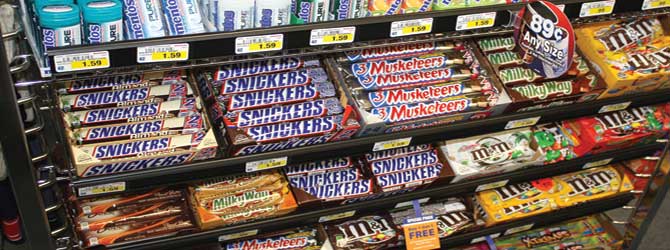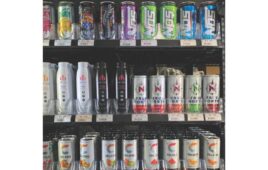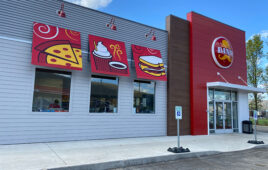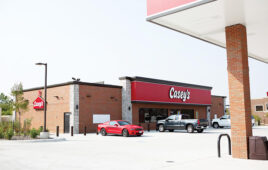 Despite the weak economy, consumers continue to indulge in candy.
Despite the weak economy, consumers continue to indulge in candy.
By Joe Bush, Contributing Editor.
The confectionery retail market has grown across all trade channels, but convenience stores have outpaced the overall retail market.
Iconic brands (Hershey, Nestlé, Mars) prowl the chocolate landscape and provide consumers an affordable indulgence in a bitter economy.
According to SymphonyIRI Group, a Chicago-based market research firm, chocolate dollar sales in U.S. convenience stores for the 52 weeks ended Dec. 25, 2011 increased 9.2% while unit sales rose 1.5%. The average price jumped nine cents for packages above and below 3.5 ounces.
Mars and Hershey dominated the top-sellers for both sizes, according to SymphonyIRI. The candy companies combined accounted for 19 of the top 20 brands in single-serve bar sizes smaller than 3.5 ounces.
Since convenience stores remain a key outlet for chocolate and because they compete on value, among other things, they have had to incorporate chocolate price hikes into that strategy. Pat Zelochoski, buyer and category manager for 33-store NOCO Express stores in Tonawanda, N.Y., said one of the challenges retailers have been facing of late is absorbing the price increases in a still-struggling economy. Many chains have been hesitant to pass this price increase onto their customers.
Generating Value
To deliver extra value to their customers, NOCO has tried bundling candy with coffee—with the help of fixtures like a 24-count counter display—as well as offering one-day discounts through its text-messaging coupon program. Selling a Snickers bar for 79 cents for one day could double sales, said Zelochoski, who added that chocolate makes up 85% of her overall candy business.
“It becomes hard to offer a value with the price up so much,” Zelochoski said. “There was a point in time where you’d be able to buy a king-sized candy bar for 99 cents, now that’s regular size. People are still looking for that lower price.
They want to buy a candy bar for 79 cents. That eats into your margin, so you have to weigh that out. Is it really worth doing (the text promotion), and for what period of time do you want to do it, if you do?”
Text coupons are an effective strategy for candy because they play into the category’s impulse appeal. As such, merchandising is crucial. While some NOCO stores are too small to have an eight-foot gondola set of candy bars, they will have up to six feet of selling space plus racks by the front counter to spur impulse sales.
Negotiating contracts with suppliers is extremely important when it comes to maximizing each store’s selling space.
“Some suppliers and candy manufacturers want you to have 65 items on a planogram to do their full contract,” Zelochoski said. “That’s tough, especially for a smaller convenience store. Plus, they often want a counter unit by the registers and seven shippers a year. The other companies are not as demanding, though they have similar contracts. We’re talking 144-plus-count shippers.”
With candy, NOCO will usually feature one hot item per month. “That amounts to one shipper a month, but we don’t want to limit it to one manufacturer, either. We want to have the variety out there for the consumer coming in,” Zelochoski said. “You want to keep it fresh.”
Tracking the Trends
Adopting best practices, such as identifying the top-selling SKU’s and jettisoning slow-moving items is a proven strategy for increasing profitability across the candy category. Chris Hobson, vice president of marketing for San Francisco-based convenience store distributor Core-Mark International, said his company has identified a few best practices for merchandising chocolate that it has built into its programs.
These best practices include:
• Stores must have top sellers in stock at all times. Core-Mark calls these “power brands.”Candy consumers tend to be very brand loyal. Approximately 34% of consumers that wanted to purchase candy leave with nothing because their brand was out of stock, Hobson said.
• Leverage the impulse nature of candy by utilizing strategically-placed points of purchase that follow
consumer traffic patterns.
• Merchandise top sellers directly below eye level and clearly call out price points.
• Have a two-tier pricing strategy that offers consumers a “two-for” value, enabling convenience stores to compete with other retail channels for the value shopper.
• Optimize shelf performance using merchandising schemes that are easy to navigate so customers don’t have to search for their brand of preference.
“We see more retailers adopting a two-tier pricing strategy. We see more retailers accepting the theory of multiple display points that align with consumer traffic points. But we are also seeing improved technology assisting retailers in ensuring that they are ordering the correct amount on top sellers,” said Hobson, whose company serves 30,000 retailers in North America, 25,000 of them in the U.S. “Retailers are also utilizing special marketing programs to showcase new items.”
For instance, Hobson said, Core-Mark’s Rookie Rack program helps with new products by providing a low-risk trial of new items, rapid placement of new items and a multi-vendor rack.
New products have boosted holiday sales especially, according to Chicago-based research firm Mintel. In 2011 Easter chocolate sales grew 10.9% over 2010, to $538 million; Christmas chocolate sales jumped 4.2% to $400 million; Valentine’s Day sales rose 4.5% to $297 million. Halloween sales, however, declined, which is a pattern Mintel attributed to the economy and downtrading of candy as consumers purchased cheaper candy items to pass out to trick-or-treaters.
While seasonal sales are important, the summer months help push candy profits.
“We do see a lift in the 100 days of summer as store transaction counts are at their highest, and this has a lot to do with the impulse nature of the product, as there are just that many more opportunities to capture that impulse magic,” Hobson said.
Another factor in chocolate’s surge is the manufacturers’ use of social media to connect with consumers. Hershey, for example, promoted Reese’s Peanut Butter Eggs on its Reese’s Facebook page and hosted a Twitter party last year to garner Easter excitement. Hershey also partnered with a parenting blog for the hour-long party and gave away prizes.




